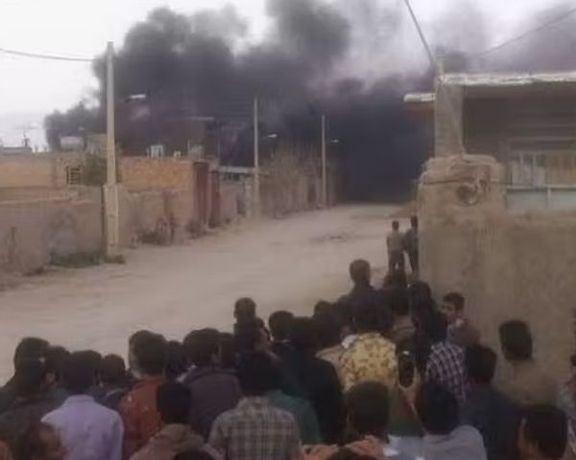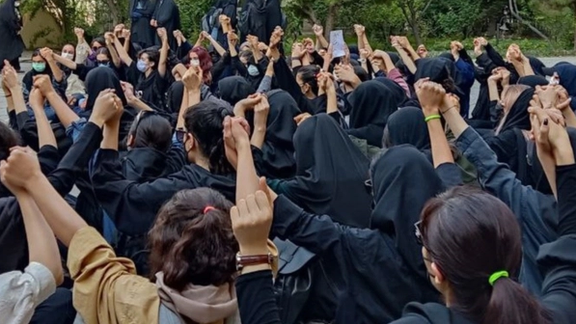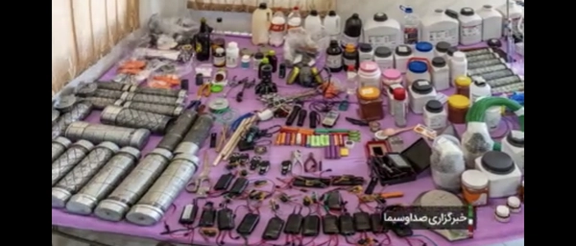IRGC Forces Surround Iranian Village Following Clashes

The IRGC surrounded a village in Iran’s West Azarbaijan province after clashes erupted between civilians and security forces.

The IRGC surrounded a village in Iran’s West Azarbaijan province after clashes erupted between civilians and security forces.
Violence broke out after residents of Agh-Darreh village in Takab had protested the arrest of family members in front of the governorate of Takab city. In what is believed to have been a case of excessive force, police and security forces turned violent, causing the IRGC to send troops to surround the village.
Hengaw Human Rights Organization reported that the situation escalated with over 50 Kurdish citizens being arrested and more than 10 people sustaining injuries. Furthermore, dozens of other citizens have sought refuge in the surrounding mountains, fearing arrest.
The majority of Iran's 10 million Kurds live in the western parts of the country, which has been subject to consistent suppression from security forces in the wake of Kurdish-Iranian Mahsa Amini's death in morality police custody. It has been the scene of numerous violent protests and even more brutal crackdowns by the regime with hundreds believed to have been killed in state-sanctioned violence.
The area's residents were also protesting a lack of jobs at the local gold mine, with the villagers among some of Iran's poorest citizens. Despite promises of employment from provincial authorities, the situation remains unresolved and the economic situation worsening.

At least 147 students from 43 universities were barred from studying during the Iranian uprising, according to a recent study.
Following the Woman, Life, Freedom protests, the Committee to Follow Up on the Status of Detainees launched a special project to document and monitor repressive actions within the country's universities. It is the first such initiative to have officially gathered information on students who were expelled or faced bans from studying for several semesters.
The many disciplinary actions had not been made public until now, though the numbers are only the tip of the iceberg, the true extent believed to be far higher than those made public.
The regime's security forces sought to control the wave of protests which began in September after the death in police custody of Mahsa Amini, by targeting universities, assaulting students, carrying out kidnappings and arrests in campuses across the country.
In May, Iran International reported that eight students had been deprived of education for up to two years or exiled to other cities as punishment for protesting a wave of chemical attacks in Iran's universities and schools which lasted several months.
In April, Iran’s Student Union Council claimed that more than 430 students had been suspended or expelled following the recent protests across the country “through an illegal process,” as reported by Iran International at the time.
At the time, US-based Human Rights Activists News Agency (HRANA) said 637 students from 144 universities had been arrested since mid-September. Other sources which have put the number at well over 700.
The official report claims the most common disciplinary measures include "one-semester suspension," affecting 64 protesting students, followed by "two-semester suspension," which impacted 52 students.
Tabriz University of Medical Sciences, Tehran University, and Allameh Tabatabai are among the universities with the highest number of disciplinary orders against their students, the report claims.

Iran claims to have smashed a network of “terrorists” across six provinces, whose handlers are in Denmark and the Netherlands, according to the government's news agency, IRNA.
In a lengthy article, quoting Iranian intelligence organizations, IRNA says that the conspiracy’s aim was to launch terror attacks during last week’s Muharram Islamic Shiite mourning events, marked by days of public gatherings in streets and mosques.
The report, blaming “Zionists” for organizing the network, claims that 43 bomb attacks were planned, including the bombing of IRGC General Qassem Soleimani’s mausoleum in Kerman — the architect of Iran’s military and intelligence network across the Middle East, killed in a US drone strike in January 2020 ordered by then-president Donald Trump.
Praising the quality of Iran's "intelligence aristocracy", the discovery it says, "is a sign of the undeniable authority of this institution in thwarting terrorist plans, and on the other hand, it shows the loss of the intelligence authority of the Zionist regime".
IRNA, a mouthpiece for the regime's top brass, claimed that the nature of the terrorists' employers has been known for years. "No one doubts the Zionist regime's [Israel] covert and hidden involvement in this matter," it claimed, threatening that the actions would reap repercussions for Israel's allies in Europe.
IRNA went on to claim that a large quantity of material related to bomb-making was uncovered in safe houses, along with weapons and accessories for street protests.
The Iranian regime occasionally makes claims of arresting terrorists and spies -- especially citing alleged Israeli intelligence agents — and uncovering caches of weapons and explosives, but rarely provides concrete details or names and affiliations of the supposed saboteurs. Court appearances of detainees or news about trials are rare and verification of these claims are impossible.
It is the second time in a matter of days that the regime has issued veiled threats to Denmark. Only last week, Iranian officials warned Denmark not to allow any acts of desecrating the Quran after several people burned the Muslim holy book in Sweden.

On Monday night, Iranian security forces used tear gas to disperse a protest in Divandarreh.
The demonstration was in response to several days of water cuts that have left residents without access to drinking water. According to reports from Hengaw human rights organization, at least four protesters were injured during the crackdown.
The protest emerged after a group of people from the Kurdish city took to the streets to voice their frustration over the continuous water shortages.
Videos of the protests circulating online depict the security forces firing tear gas in an attempt to confront the demonstrators.
Divandarreh has been grappling with frequent and widespread drinking water cuts for several weeks. Initially, the city's water company attributed the issue to a broken water transmission line and repeatedly promised to repair and restore the water supply. However, each time the repair was announced, the water cuts persisted, causing immense frustration among residents.
The worsening water crisis in Iran, believed to be exacerbated by global climate change and compounded by the inefficiencies of the Islamic Republic's management, has raised concerns among experts about potential social and political crises.
The crisis reflects a larger issue in Iran, as water reservoirs across the country have reached an all-time low, prompting local media and officials to warn about imminent nationwide water rationing.

Two Iranian female journalists, who were arrested during anti-regime protests, have each been sentenced to three years and seven months in prison.
The court found Saeedeh Shafiei and Nasim Soltanbeigi, detained since January, guilty of propaganda against the system as well as "gathering and collusion against the system," resulting in an additional eight months of imprisonment for campaigning against the regime. The sentences also include a two-year ban on leaving the country and a two-year ban on membership of groups.
In addition, the journalists opposed compulsory hijab during court proceedings, which led to further controversy, as reported by the US-based Human Rights Activists News Agency (HRANA).
A third woman, Mehrnoush Zarei, who was arrested at the same time, has been acquitted of the charges.
In connection with this case, Ali Pourtabatabaei, the editor of the "Qom News" website, is also facing legal repercussions. His trial was held on charges of "publishing lies" regarding the poisoning of students in Iran and "contact with foreigners under the guise of espionage."
These reports are indicative of an increase in pressure against journalists. Earlier this month, Behrooz Behzadi, who is in his late 70s as is the editor in charge of Etemad newspaper, ‘accused of publishing false content’ following a complaint by Revolutionary Guard Corps and banned from any kind of press activity for one year.
The increasing repression against journalists has drawn condemnation from various quarters, including the Tehran Journalists’ Association, which denounced the issuance of "heavy and unconventional judicial sentences against journalists" and urged the judicial system to halt such practices.
The Islamic Republic's track record as a major repressor of the media has drawn international attention. However, the current wave of repressions has escalated since the nationwide uprising against the regime.

A group of children openly mocked Hamas during a demonstration in Gaza on Sunday, provoking threats to journalists.
A video on social media shows the children chanting "Shia! Shia!" in reference to Hamas' alleged ties with Shiite Iran.
Amidst the demonstration, Ihab Fasfous, a veteran Gaza journalist, found himself at the center of a confrontation with Hamas, the governing authority in the Gaza Strip.
According to witnesses, he was threatened twice by the authorities and then demanded to see identification documents of those making the threats. Despite this, he was later arrested by Hamas.
The situation has raised concerns among media organizations, particularly the Palestinian Journalists Syndicate, which has strongly condemned the actions of Hamas security forces against impartial reporters. In a statement, the syndicate also addressed an incident involving journalist Walid Abdel Rahman, a prominent member of the General Secretariat of the syndicate. Rahman, a correspondent for Palestine TV was reporting on a march in Jabalia refugee camp when he was beaten by Hamas security forces. This incident reflects a growing pattern of preventing journalists from performing their duties and covering peaceful marches across the Gaza Strip.
The Palestinian Journalists Syndicate said, "We strongly condemn the attack by Hamas security forces on journalist Walid Abdel Rahman. It is unacceptable that journalists are being subjected to violence and intimidation while simply doing their job. The syndicate stands in solidarity with all journalists facing such threats and calls for their immediate release."